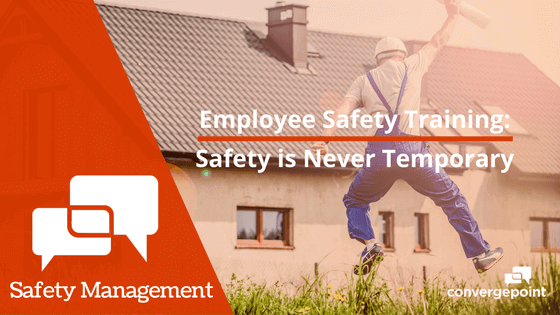Employee Safety Training and Management: Safety is Never Temporary

‘Temporary work’ or ‘temporary employment’ refers to an employment situation where the working arrangement for a worker is limited to a pre-determined period of time that is based on the specific needs of the employer. Other terms also used to denote temporary work include: ‘contractual’, ‘seasonal’, ‘interim’, ‘casual’, “outsourced.” Even ‘freelance’ workers are technically considered temporary workers. Some temporary, more highly skilled professionals (particularly those engaged in white-collar work, such as law, finance, and accounting) also refer to themselves as ‘consultants.’ If those consultants are in your workplace for a period of time, then they, too, should be considered temporary workers.
Temporary Workers Considered Employees
Temporary workers are a common reality in the modern American workplace. According to an estimate provided by the American Staffing Association, there are, on average, more than three million temporary and contract employees working for America’s staffing companies each week. During one year, staffing companies hire nearly 17 million temporary and contract employees. Temporary employment has grown exponentially since the 1980s and early 1990s due to persistent business trends regarding downsizing and restructuring. However, the tendency by many companies continues to be that of treating temporary workers as the ‘other’, as if somehow apart from the fully employed workforce.
Safety Management and Temporary Workers
With regard to safety management, this is a huge mistake. For one thing, although only in the workplace temporarily, these workers are still a logistical and practical reality in an organization’s employ. Not involving them fully in the company’s safety management system is akin to pretending that these workers are not physically present, which is a costly mistake. For another, any temporary worker is as much a walking and breathing hazard in the workplace as any employee. In fact, they could even pose a greater hazard if they are not properly informed of a company’s safety procedures, HIRA and incident reporting system, for starters.
Repercussions from Lack of Safety with Temporary Workers
OSHA is very clear on the role of employers and the safety of temporary workers. OSHA states that it “recommends that the temporary staffing agency and the host employer set out their respective responsibilities for compliance with applicable OSHA standards in their contract.” OSHA goes further – it states unequivocally that both a staffing/labor agency and the host employer are jointly responsible for maintaining a safe work environment for a given temporary worker. This mandate includes safety-related training, hazard and risk communication, and recordkeeping requirements, as just a few examples. OSHA also makes the observation that the agency has “concerns that some employers may use temporary workers as a way to avoid meeting all their compliance obligations under OSHA and other worker protection laws…”
In a scathing 2015 report, also picked up by Fortune Magazine, OSHA expressed its deep concern with what it saw as an increased risk of injuries in the workplace due to “important changes in the structure of the employment relationships in U.S. workplaces…” OSHA viewed two principal culprits in this trend, namely what it views as the purposeful misclassification of wage employees as ‘independent contractors’, as well as the widespread use of temporary workers.
The Future of Safety Management for Temporary Workers
Fortune offered a simple reason as to why safety declines in the face of these hiring trends: “A company that relies on temporary employees has little financial incentive to ensure workers’ wellbeing.” Although this might be true, many argue the unethical nature and legal implications of this perception. Temporary workers are not the workplace equivalent of passing ships in the night. Their safety, health, and wellbeing are as much an obligation of an employer as that for any employee. As always, workplace safety is not a privilege but an ethical and legal right – and one which makes business sense anyway.
Are you looking for a better way to manage safety incidents and training? ConvergePoint offers health and safety management software on Microsoft SharePoint and Office 365 to serve as the backbone of an organization’s compliance and risk management programs. Learn more about our safety and incident management solutions here.
Download Incident Management Checklist
Industries served
Education
Improve facility management, student health and safety, workforce and administration training, and related incidents.
Healthcare
Adhere to federal regulations, administer employee training programs, and enhance hospital facility management.
Manufacturing and Retail Industry
Upgrade facility management and safety measures, diminish workforce injuries, and enhance employee training programs.
Financial Services and Banking
Manage employee complaints and working conditions, injury reports, accidents, and improve compliance training programs.
Insurance and Employee Benefits
Increase training program effectiveness, reduce workplace injuries and complaints, and meet FTIC and SEC regulations.
Energy and Utilities
Abide by stringent government regulations, provide proper safety training programs, and mitigate workforce and onsite injuries.
Transportation
Outline health and safety measures for drivers and pilots, abide by federal regulations, and communicate processes for hazardous materials (Hazmat).
